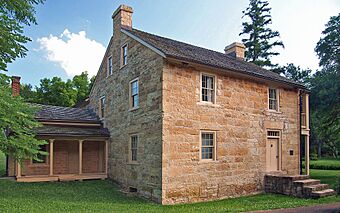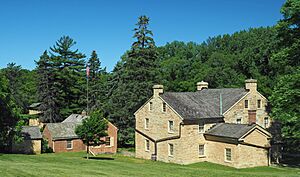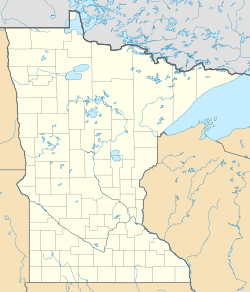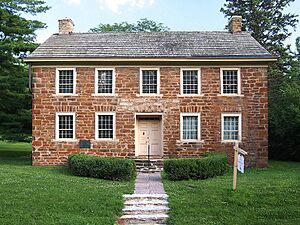Sibley Historic Site facts for kids
|
Henry H. Sibley House
|
|
|
U.S. Historic district
Contributing property |
|

The Henry H. Sibley House from the north
|
|
| Location | Willow Street, Mendota, Minnesota |
|---|---|
| Area | 0.5 acres (0.20 ha) |
| Built | 1836 |
| Part of | Mendota Historic District (ID70000293) |
| NRHP reference No. | 72000676 |
| Added to NRHP | January 20, 1972 |
The Sibley Historic Site is a special place in Mendota, Minnesota. It was once the home of Henry Hastings Sibley, who was a very important person in Minnesota's history. He managed a big fur trading company and later became Minnesota's first governor!
This site is one of 26 historical places managed by the Minnesota Historical Society. It has four old limestone buildings and a large grassy area. You can visit three of these buildings on a tour. These include a cold storage building from 1843, used by the fur company, and the home of another fur trader, Jean-Baptiste Faribault, built in 1840.
Contents
The Sibley House: A Historic Home
The Sibley House is thought to be the oldest private house in Minnesota. It was built between 1835 and 1836. More than 100 workers, both white and Dakota people, helped build it. John Mueller was in charge of the construction.
Building the Sibley House
The house was made from large limestone blocks. These blocks were cut from a quarry nearby. Henry Sibley lived in this house by himself for eight years.
Sibley's Family Life and Home Changes
After Sibley married Sarah Jane Steele, he made some changes to the house. His business office became a cozy parlor. A new part was added to the house. This addition included a kitchen, a dining room, two more rooms upstairs, and an office on the east side.
A Place of Government History
Important plans for the Minnesota Territory were made in Sibley's office. In May 1840, the house even became the temporary headquarters for the territory. Governor Alexander Ramsey stayed there as Sibley's guest.
New Owners and Uses
In 1862, General Sibley moved to St. Paul. He sold his home to St. Peter's Catholic Parish. From 1867 to 1878, Catholic Sisters used the house as a school and a convent. They added a bell tower to the roof and changed the inside.
Falling into Disrepair
For the next few decades, different people rented the house. An artist named Burt Harwood used it as a studio and art school in the summers of 1897 to 1899. Later, the house was used as a storage place. Sadly, it was then left empty and became a shelter for people traveling by train. These people took apart the floors and stairs for firewood, and the house started to fall apart.
Saving the Sibley House
On April 19, 1910, the house was saved! The St. Paul chapter of the Daughters of the American Revolution (DAR), Mrs. Lucy Shepard McCourt, and Archbishop John Ireland worked together. DAR groups from all over Minnesota helped restore the house. It opened to the public on June 14, 1910.
Current Management of the Site
In May 1997, the DAR gave ownership of the Sibley Historic Site to the State of Minnesota. The Minnesota Historical Society took over managing it. As of 2015, the site is also run in partnership with the Dakota County Historical Society.
The Faribault House: A Traveler's Inn
Right next to the Sibley estate is the house of Jean Baptiste Faribault. He built this house in 1839. It is a Colonial-style house made of local yellow sandstone. The front of the house is made of red sandstone.
Faribault's Family and the Hotel
Faribault left the house after his wife passed away in 1847. His grandson, George Faribault, then turned the building into a hotel. Many different people stayed at this inn, including river travelers, priests, teachers, explorers, and government officials.
Restoring a Historic Landmark
The house was sold and rented to various people over the years. Eventually, it also started to fall apart. By the 1880s, Mendota was no longer a busy center. However, people realized the Faribault house was very important historically. In 1934, the State Highway Department began restoring the house. This was part of a government project called the Public Works Administration.
In 1935, the partially restored home was given to the DAR. They finished the restoration work. The house and its grounds opened to the public on May 5, 1937.
The Dupuis House: A Tea House History
On the southeast side of the historic site is the Dupuis House. It was built in 1854 for Hypolite Dupuis. He was a fur trader and also worked as a private secretary for General Sibley for many years. This house is made of bricks from Milwaukee, Wisconsin.
Changes Over the Years
In 1869, the house was sold to the Fee family. It stayed in their family until the Minnesota DAR bought it in 1924. In 1928, the house was changed to become a tea house. A porch was built on the east side, looking out over an old-fashioned garden. Later, a large, glass-enclosed porch was added to the west side.
A Popular Spot
The Sibley Tea House became one of Minnesota's most popular tea houses. Thousands of guests visited each season. It remained open until the 1970s. Today, the Dupuis House holds the offices for the Sibley Historic Site. It also houses the offices for the Mendota Mdewakanton Dakota Tribal Community.
See also
- List of the oldest buildings in Minnesota







